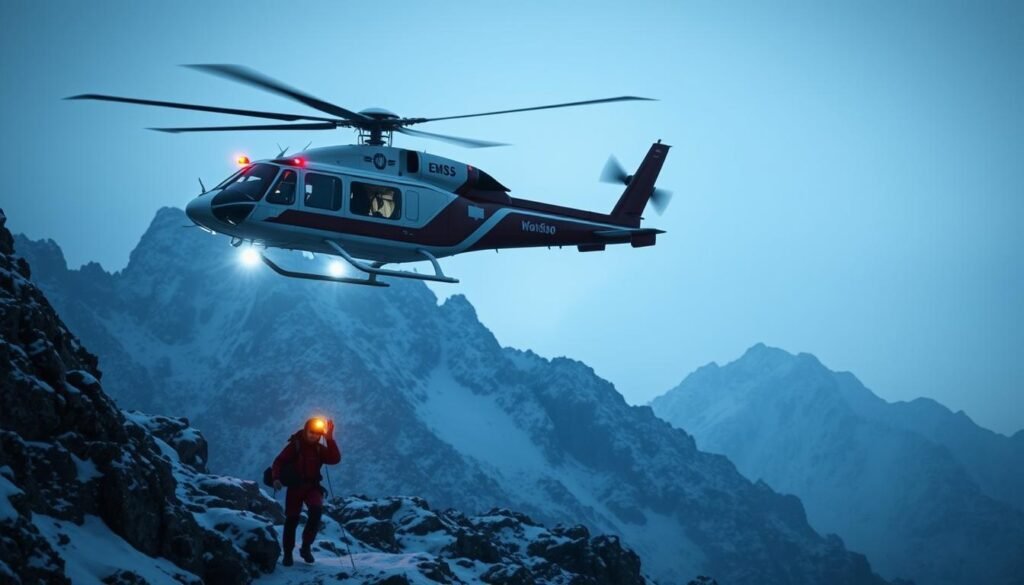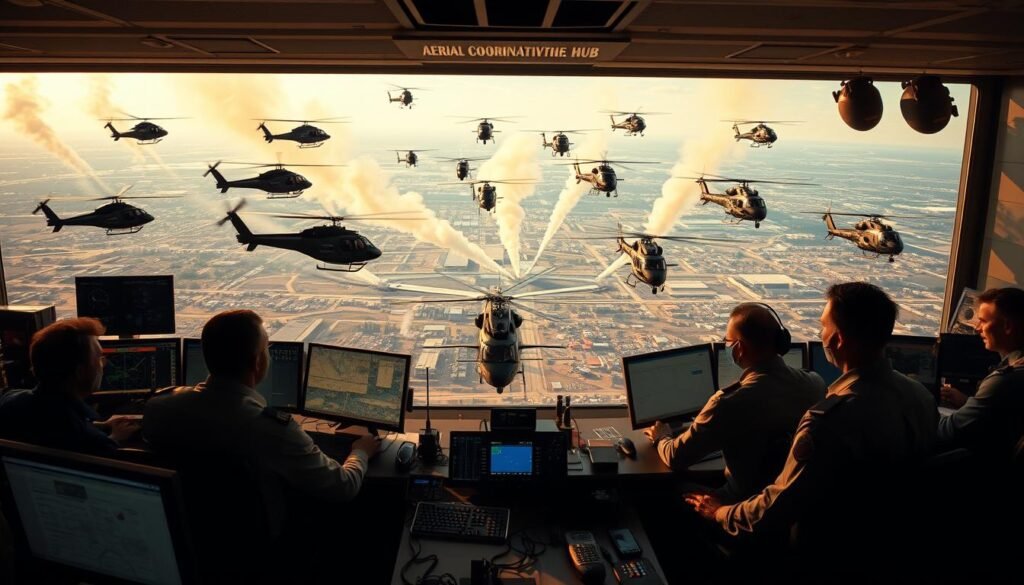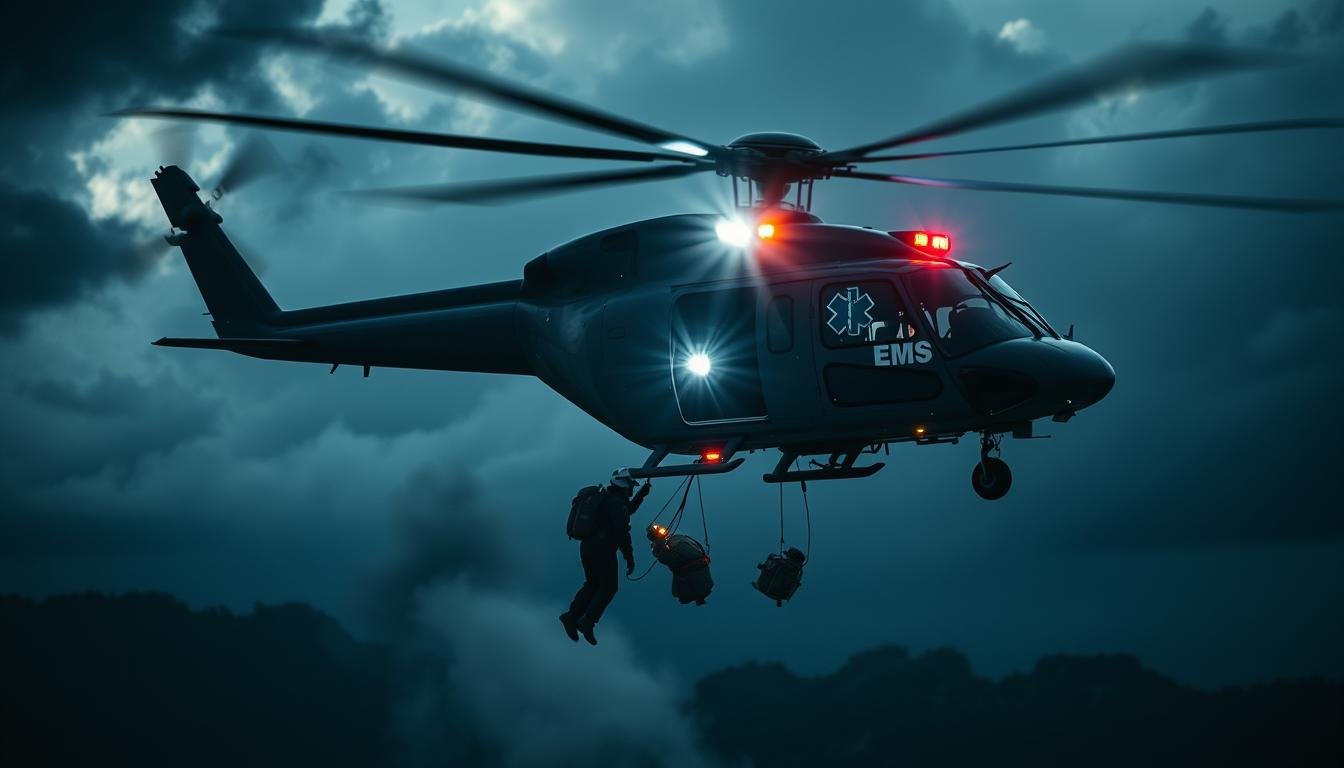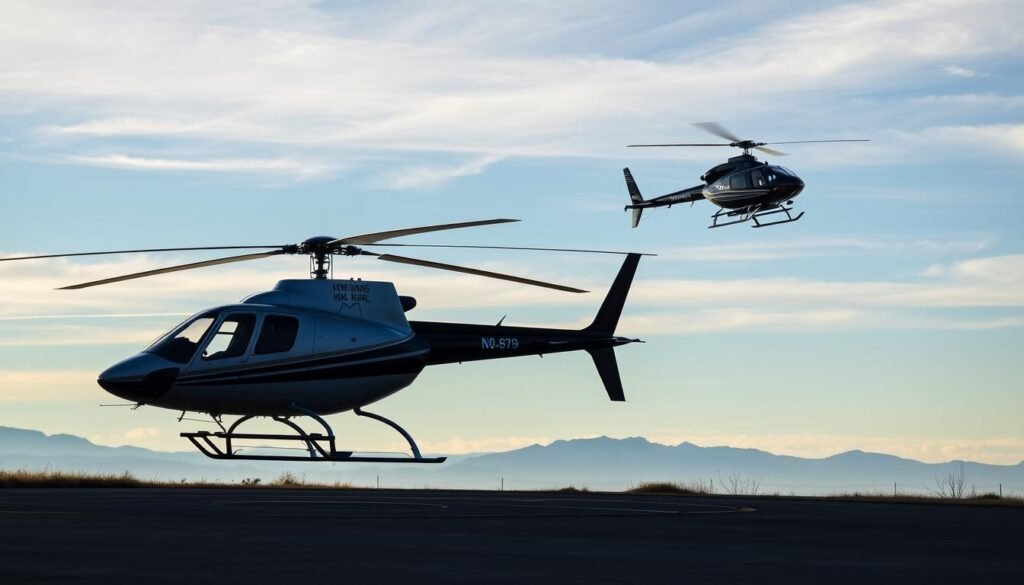On a late October morning in North Carolina, a single aircraft broke a long silence over a flooded neighborhood. The crew delivered filtration systems, solar lights, and food to families cut off by Hurricane Helene. That swift action changed the first day of recovery for many.
Across wildfires, earthquakes, and storms, helicopters reach places roads cannot. In 2024, Sikorsky S-70i Black Hawks aided CAL FIRE with retardant drops and hoist work, while air medical services logged hundreds of thousands of transports nationwide.
This guide frames the pilots’ role and the tactics that make rapid assessments, hoist rescues, and supply runs possible. It links real U.S. case examples to proven procedures, so leaders can sharpen coordination, safety, and mission outcomes when time matters most.
Key Takeaways
- Air platforms provide speed and reach when roads fail.
- Hoist and precision landings enable access in tight or debris-filled zones.
- Integrated communications keep crews aligned with incident command.
- Case studies show measurable community impact and faster recovery.
- Standardized training and protocols improve safety and consistency.
Understanding The Mission: How-To Overview For Disaster Relief Air Operations
Rapid access by charter and dedicated air services often defines the first 24 hours after a major event. Charter flights can launch within hours when airports are closed or overwhelmed, closing a vital access gap while commercial options recover.
Mission types vary from reconnaissance and search to medevac, supply lift, and wildfire suppression. Each trigger carries distinct priorities that shape aircraft choice, crew makeup, and sortie length.
Operations plug into the Incident Command System so tasking and accountability remain clear. Aviation branches report through the operations section to align sorties with incident objectives and ground EOC needs.
Preparedness rests on six pillars: workforce, training, management, standards, equipment, and infrastructure. These categories define readiness for sustained waves and single, life-saving sorties.
- Use scoping flights to validate routes, hazards, and landing zones before higher-risk insertions.
- Match medical services capability to patient acuity—basic transport to ICU-level care—when assigning aircraft.
- Standardized checklists and comms plans reduce friction and speed tasking during complex missions.
“The most effective missions are those that are rehearsed, standardized, and integrated with local command.”
After-action feedback loops refine tactics and resource allocation for subsequent waves, improving safety and mission outcomes over time.
User Intent And Article Roadmap: How EMS Helicopter Pilots Support Disaster Relief & Emergency Response
This section frames practical, step-by-step guidance for planning, launching, and coordinating aerial operations across a crisis lifecycle. It highlights speed to scene, trauma expertise, and access to remote terrain as core advantages cited in recent literature.
Readers should expect clear tasks that move from aerial assessment to search rescue, supply delivery, medevac, wildfire work, communications, weather checks, landing-zone management, aircraft selection, and training.
Key aims include standard checklists, interoperable comms, and annual exercises with fire, police, and military partners to maintain readiness (BMC Emergency Medicine, 2023).
- Clarify roles for flight crews, medical teams, and mission coordinators to speed decisions.
- Embed measurable benchmarks and field-tested tactics for safe, repeatable operations.
- Emphasize equipment, training, and communications that shape mission effectiveness.
“Preparedness relies on integration, disciplined execution, and exercises that mirror real-world complexity.”
The roadmap ahead signals examples, checklists, and data to support planning and resource requests. It encourages adapting processes to local policy and airframe limits while keeping core standards consistent.
How To Conduct Rapid Aerial Assessments Over Disaster Areas
Rapid visual sweeps from above let teams map impact perimeters and prioritize lifesaving routes. Crews must confirm airspace limits, check NOTAMs, and coordinate Temporary Flight Restrictions with ATC and incident command before takeoff.
Establishing Safe Airspace And Temporary Flight Restrictions Coordination
Prioritize deconfliction by defining air corridors, altitudes, and handoff points with the air operations branch. Maintain strict radio discipline and standard position reports on assigned frequencies.
Using Surveillance Systems For Real-Time Damage Surveys
Deploy EO/IR cameras, mapping suites, and live video downlink to feed incident command. Use orbit patterns, grid scans, and racetrack holds to collect time-stamped imagery of key infrastructure.
- Capture lifelines: roads, bridges, hospitals, water and power nodes.
- Log geotagged secondary hazards and mark temporary landing zones.
- Integrate findings with GIS to update a common operating picture and assign SAR or supply missions.
| Assessment Task | Tool/Pattern | Outcome |
|---|---|---|
| Perimeter Mapping | Grid Scan / Racetrack | Time-stamped impact boundary |
| Critical Lifelines Check | EO/IR + GIS | Access and routing plan |
| Hazard Identification | Close Hover Inspections | Marked no-go zones & LZ notes |
Teams should reassess often as weather and conditions change, and translate survey data into immediate tasking. For broader context on aerial missions in crisis, see air operations case studies.
How To Execute Search And Rescue Operations With Speed And Precision
Rapid, coordinated tactics shrink search areas fast and let trained crews focus on probable survivor locations. Clear tasking, reliable comms, and practiced insertion techniques turn sightings into timely recoveries.

Deploying Hoists And Winch Systems In Confined Or Remote Areas
Hoists and winches enable direct lifts from places crews cannot land. Teams must standardize hoist briefs that cover power margins, cable angles, static discharge, and survivor packaging.
- Perform hover checks and wind assessments before committing to a lift.
- Choose short-haul, hoist, or skid offload by terrain and patient condition.
- Carry redundant rigging and spare slings in case of equipment failure.
Integrating Thermal Imaging And Night Vision For Low-Visibility SAR
IR sensors and NVGs extend working hours and reveal heat signatures in smoke or darkness. Use structured search patterns—expanding square, sector, contour—to conserve fuel and duty time.
Coordinating With Ground Teams For Survivor Extraction
Robust air-ground communication is essential. Assign SAR talkgroups, confirm extraction points, and log survivor IDs and destinations for accountability.
“USCG aviation assets account for roughly 60% of successful rescues; combined efforts with local and private teams increase coverage during major incidents.”
For technology advances that improve these linkages, see modern aircraft communications and sensors.
How To Deliver Essential Supplies When Infrastructure Fails
When roads are cut off, aerial delivery becomes the fastest path to sustain isolated communities. Helicopters can move thousands of pounds to remote sites; during Hurricane Helene (Oct 2024) crews flew water filtration systems, solar lights, and emergency food to cut-off neighborhoods.
Air transport often reaches areas about ten times faster than ground convoys, making careful load planning essential to maximize each sortie.
Load Planning For Water, Food, Medical Supplies, And Equipment
- Prioritize life-sustaining commodities—water, MREs, medical kits—within weight and balance limits.
- Use sling loads and cargo nets for high-volume runs where landing zones are unsafe due to debris or flooding.
- Sequence sorties to sustain daily rations by population estimates and confirm demand with ground distribution nodes.
- Pre-rig pallets and standardize manifests to speed turnarounds and preserve chain-of-custody.
- Integrate specialized equipment like external pods or buckets only when they fit center-of-gravity and mission profiles.
- Build contingency fuel plans and alternates to offset dynamic site conditions.
- Capture delivery metrics—pounds delivered and recipients reached—to inform commanders and justify continued air allocations.
- Prepare shift rotations that respect duty limits while keeping an air bridge until ground access restores.
| Task | Method | Benefit |
|---|---|---|
| Water Delivery | Sling Loads / Pallets | Rapid mass distribution to clusters |
| Medical Kits | Secured Cabin Transport | Maintains sterile packaging and accountability |
| High-Value Equipment | Pre-rig + Manifest | Faster turnarounds; inventory visibility |
| No-LZ Supply | Precision Air-Drop | Safe delivery when landing is infeasible |
“Air transport can reach isolated locations far faster than ground convoys, reducing time-to-assist and saving lives.”
Coordinate logistics clusters and EOCs early and use vetted routing to move high-priority items first. For operational case context on air-based delivery, see air rescue and relief missions.
How To Perform Medical Evacuation And Provide Critical Care In Flight
Configuring a medical aircraft for ICU-level care allows clinicians to deliver advanced interventions during transit. Air medical services in the U.S. complete over 550,000 transports annually, and historic events show the scale of need—more than 25,000 patient evacuations occurred by air during Hurricane Katrina.

Preparation centers on equipment, staff, and coordination. Aircraft must hold monitors, ventilators, infusion pumps, suction, and oxygen to sustain ICU-level interventions. Redundant power and secure mounts keep devices functional during turbulence.
Configuring Aircraft For Air Ambulance And ICU-Level Care
Standard kits should include blood products, RSI-capable tools, and trauma analgesia. Infection control must cover isolation units and terminal disinfection between sorties.
Synchronizing With Hospitals And Emergency Medical Services
Pre-alerts and telemetry reduce ED dwell time. Teams must align with regional medical directors and hospital helipads for rapid handoffs to burn centers, cath labs, or trauma units.
| Configuration Task | Key Items | Benefit |
|---|---|---|
| Monitoring & Support | Cardiac monitors, ventilator, infusion pumps | ICU-level care en route |
| Staffing | RSI-capable clinician, critical care nurse | Appropriate care by acuity |
| Logistics | Telemetry, pre-alert, helipad coordination | Faster ED transfer and specialty access |
| Infection Control | Isolation units, terminal disinfection | Reduced cross-contamination risk |
- Standardize mission acceptance and triage to use rotor-wing capacity for the highest-need patients.
- Document care thoroughly for continuity, QA, and after-action review.
- Train crews on austere airway management and damage-control resuscitation tuned to flight constraints.
“HEMS can deliver higher clinical care levels than ground ambulances due to experienced crews; preparedness emphasizes protocols, PPE, and integration with regional healthcare and ICS.”
How To Support Wildfire Response Using Specialized Helicopters
Aerial units combine real-time scouting with precision drops to shape containment lines and protect structures.
Water And Retardant Drops With Bambi Buckets And Precision Targeting
Use Bambi Buckets with flow control and timed releases to saturate flanks and hotspots while minimizing overspray. Coordinate drop sequencing with air attack supervisors and mark targets before run-ins.
Wind, humidity, and terrain turbulence influence run geometry and egress routes. Factor those weather conditions into entry angles and safety margins to keep crews safe and drops accurate.
- Balance payload and cycle time versus nearest water source to maximize gallons-per-hour.
- Integrate reconnaissance to guide ground divisions and protect evacuation corridors.
- Enable rapid role switching by equipping aircraft with modular, specialized equipment for suppression, hoist rescue, or medevac tasks.
- Limit night operations to NVG-qualified crews and approved procedures.
Maintain constant comms with ground divisions and capture mission data—drop locations, volumes, and observed effects—to feed planning cells and after-action reviews.
“CAL FIRE deployed a Sikorsky S-70i Black Hawk during the 2024 Park Fire, configured for retardant drops, hoist rescue, and night operations as part of initial attack.”
For tactics on inter-air coordination and sequencing, see multi-helicopter coordination.
How To Optimize Communication Systems And Incident Command Integration
When radios and tracking work together, tasking moves from guesswork to precision. Clear protocols let crews and command exchange intent fast and keep missions safe.

Standardized Radio Protocols And Real-Time Position Reporting
Standardize call signs, check-ins, and radio plans to cut airtime congestion. Crews should use short, structured sitreps and predefined phraseology.
Use ADS‑B or approved GPS feeds for live position reporting to the Air Operations Branch and ATC. This reduces misidentification and speeds tasking.
Working Within ICS With FEMA, USCG, And Local Emergency Responders
Integrate comms into ICS documentation so sorties map to operational periods and objectives. Private charter services often operate under FEMA contracts and must align with unified command.
Establish gateways and cross‑band solutions to link federal, state, and local radios. Add SATCOM or cellular gateways for redundancy when terrestrial links fail.
| Function | Tool | Benefit |
|---|---|---|
| Voice Discipline | Standard Radio Plan | Clearer channels; fewer miscommunications |
| Tracking | ADS‑B / GPS Feed | Real-time positions for air deconfliction |
| Interoperability | Cross‑Band Gateway | Seamless link between agencies |
| Redundancy | SATCOM / Cell Gateway | Maintains comms when local systems fail |
Train crews on ICS roles and terminology so they integrate quickly with FEMA, USCG, and local responders. Conduct pre-briefs and hotwash sessions to identify gaps and update procedures.
For staffing templates and role descriptions used by air medical services, review a sample cover letter and related resources at air medical services cover letter.
“A unified comms plan reduces clutter and speeds safe tasking across agencies.”
How To Assess Weather Conditions And Operate Safely In Adverse Scenarios
Real-time forecasts and on-scene observations together set the boundary between safe flight and unacceptable risk. Crews should anchor decisions to predefined criteria that limit exposure to high winds, low ceilings, and reduced visibility.
Establish conservative go/no-go thresholds tailored to mission type. Include clear wind, ceiling, visibility, and turbulence limits so teams avoid incremental risk creep under pressure.
Use advanced radar, pilot reports, and fire weather forecasts to spot ash clouds, convective cells, and rapid wind shifts. Adjust routes and altitudes to bypass mechanical turbulence near terrain and volcanic plumes that threaten engines.
Plan performance margins for density altitude impacts on lift, hover, and takeoff distances. Employ speed management and energy-state control when encountering gust fronts or wind shear to preserve maneuvering reserves.
Pre-brief escape routes, alternates, and fuel contingencies. Pair meteorological data with mission urgency to keep priorities aligned and prevent unsafe compromises.
Train crews in inadvertent IMC recovery and maintain instrument proficiency where applicable. Coordinate with air attack or Air Ops for live, localized updates and document weather-driven deviations to refine future decision aids.
For further guidance on operational scheduling and safety in changing conditions, review weather impacts on medical flight scheduling.
How To Establish Safe Landing Zones And Manage On-Scene Safety
Establishing a secure landing area starts with a clear approach and verified surface conditions. Teams must size the landing area to the aircraft and keep approach and departure paths free of wires and loose debris.
Assign an LZ officer to mark wind, control the perimeter, and enforce crowd standoff distances. They confirm surface firmness and slope to reduce the risk of dynamic rollover or landing gear damage.
Coordinate with ground units before committing to land. Secure hazards such as fuel leaks, downed power lines, and foreign object debris. Use dust‑abatement measures and rotor‑wash protocols to preserve visibility near structures and people.

- Enforce a sterile cockpit during critical phases to limit distractions.
- Stage ambulances and fire units outside rotor arcs with controlled access for handoff.
- Implement night LZ lighting standards to avoid glare and preserve depth perception.
| Procedure | Action | Benefit |
|---|---|---|
| LZ Size & Marking | Match aircraft type & mark wind | Safe approach and exit corridors |
| Surface Evaluation | Check firmness & slope | Reduces rollover and gear damage |
| Abort Criteria | Define obstacles & wind limits | Quick decision to go-around |
Aftershocks or structural instability in urban areas require reassessment before reuse. Clear abort criteria and steady communications keep on-scene operations safe and predictable.
How To Select Aircraft And Specialized Equipment For The Mission
Aircraft choice and mission fit drive sortie tempo, patient access, and supply throughput. Teams should match platform capability to mission distance and lift needs before committing assets.
Balancing Range, Payload, And Speed For Mission Profiles
Match range, payload, and speed to route length, lift requirements, and turnaround time.
Select airframes that offer hoists, NVG, and external load provisions when SAR, medevac, or supply runs are likely. Cabin volume and door layout matter for litter access and in-flight care.
Validate performance for elevation and temperature to keep density altitude margins. Equip aircraft with modular kits so crews can re-role between reconnaissance, rescue, and firefighting without long reconfigurations.
| Platform | Passengers | External Load | Typical Speed | Range |
|---|---|---|---|---|
| Airbus AS-350 B3 | Up to 5 | 2,500 lb | ~160 mph | ~345 mi |
| Bell 205A-1++ | 9 | 4,000 lb | ~115 mph | ~345 mi |
| Bell 407HP | 6 | 2,500 lb | ~161 mph | ~250 mi |
| Bell 429 / Bell 412EPX | 7 / 9 | 2,000 lb / 4,000 lb | ~150 mph / ~140 mph | ~390 mi / ~361 mi |
Practical checks: ensure parts availability, qualified crews, and local fuel caches before deployment. Account for ground resources, sling gear, and maintenance support at remote bases.
“Standardize loadmaster procedures for consistent weight and balance in dynamic tasking.”
How To Coordinate Multi-Agency Operations For Maximum Impact
Formalized liaisons and real-time tracking let diverse operators act as a single, accountable aviation force. Clear leadership in the aviation branch speeds tasking and reduces overlap.

Aligning Resources Across Federal, State, And Private Air Services
Establish a unified command with named liaisons for federal, state, and private services. Use pre-negotiated MOUs and FEMA contract pathways so private operators join quickly under common rules.
Track resources with GPS feeds to map coverage and avoid duplication. OCHA-style databases can speed international charter sourcing when cross-border assets are required.
Deconflicting Airspace And Prioritizing Missions
Define altitude blocks, time separations, and route corridors with ATC and Air Ops. Create a prioritization framework that ranks life safety, incident stabilization, and property protection.
| Function | Action | Benefit | Notes |
|---|---|---|---|
| Command | Unified Aviation Branch | Faster Decisions | Includes federal and state liaisons |
| Airspace | Altitude Blocks & Corridors | Safe Deconfliction | Coordinate TFRs and military slots |
| Logistics | Fuel & Maintenance Hubs | Sustain Sorties | Joint staging areas for crews |
| Tasking | Priority Matrix | Clear Mission Focus | Balances search rescue and supply runs |
Daily sitreps and joint debriefs keep leaders and the public informed about progress. Transparent metrics help align responders and teams for an efficient response to the disaster.
How To Plan Missions For Speed, Support, And Sustainability
Prebuilt mission packages compress decision time and let teams launch within the first operational window. Teams should include preplanned routes, alternates, and fuel strategies so sorties start fast once clearance arrives.
Preparedness pays off. Charter aviation can resume within hours after clearance (IATA), and FEMA data shows roughly $6 saved in recovery for every dollar invested in readiness. Pre-disaster contracts, SOPs, and training are high-return measures.
During operations, prioritize clear command, mission triage, and routine safety checks. Stage aircraft and crews forward to raise sortie rates while protecting duty limits and maintenance windows.
| Element | Action | Benefit |
|---|---|---|
| Mission Package | Preplan routes, alternates, fuel | Faster launch; fewer delays |
| Forward Staging | Preposition crews and aircraft | Higher sortie tempo; faster aid |
| Decision Matrix | Allocate assets by scenario | Objective prioritization |
| Performance Dashboard | Track patients moved, pounds delivered | Data-driven planning |
Protect continuity by rotating crews, scheduling inspections, and keeping parts pipelines open. Prearranged staging areas with fuel bladders, power, and comms preserve mission tempo when local systems fail.
“Embed finance and logistics leads early to manage costs and preserve operational focus.”
Finally, apply lessons learned daily. Iterative updates to flight plans, safety thresholds, and coordination mechanisms improve recovery outcomes across varied scenarios.
How To Train, Drill, And Maintain Preparedness For HEMS Operations
Preparedness depends on regular, realistic exercises that test crews, equipment, and command links under stress.
Annual Exercises, Standards, And Performance Evaluations
Schedule annual full-scale exercises with measurable objectives for hoist work, medevac flow, and multi-ship coordination. These events verify procedures and reveal shortfalls in personnel and logistics.
Audit performance through structured evaluations and document results to target retraining and to update standards.
Protocols, PPE, And Safety Systems For High-Risk Conditions
Standardize checklists for infection control, decontamination, and patient isolation units used during pandemics and toxic incidents.
- Stock PPE and validate donning/doffing during drills.
- Confirm equipment and systems redundancy, including comms and navigation, before each surge.
- Define clear abort criteria that empower crews to stop operations when risk exceeds limits.
Building Human Resources Capacity And Leadership
Develop depth through cross-training, mentorship, and credentialing so medical personnel rotate without loss of capability.
Invest in leadership pipelines and integrated scenario work with fire, police, and military partners to boost interoperability and ICS fluency.
“Regular, measurable training preserves readiness and reduces operational risk.”
For a practical preflight checklist and gear validation, consult the pre-flight inspections checklist.
Challenges And Limitations In Disaster Air Response
Cost, regulations, and environmental hazards frequently force planners to prioritize which missions fly. Operating rates can range from $2,000 to $15,000 per flight hour, so leaders must justify sorties against impact and available funding.
Weather ceilings—high winds, ash, turbulence, and low visibility—often ground aircraft or constrain safe profiles. Teams must accept conservative limits to protect crews and assets.
Regulatory hurdles add delay: TFRs, military deconfliction, cross-border customs, and certification checks can slow deployment. Ground communications and ATC saturation further impede timely tasking.
- Acknowledge cost pressures and require strict mission justification.
- Plan for limited LZ options, debris, and powerline hazards that complicate access.
- Address infrastructure gaps—fuel, maintenance support, and secure staging areas.
- Mitigate frequency congestion with redundant links and disciplined radio procedures.
- Anticipate crew duty limits, fatigue, and psychological strain during prolonged operations.
- Prepare for aircraft shortages and parts delays when multiple incidents compete for assets.
After-action analysis should convert lessons into concrete changes in doctrine, logistics, and training so services and ground partners are more ready next time.
Technology And Innovation Elevating Emergency Air Services
Connected systems—SATCOM, precision navigation, and unmanned platforms—are reshaping aerial operations. These tools let teams keep situational awareness when ground nets collapse and expand safe working windows in marginal conditions.
Satellites provide resilient communication links to maintain command-and-control beyond cell coverage. Advanced weather radar and EO/IR sensors broaden usable hours and boost mission safety.
GPS-guided navigation and real-time tracking cut route times and reduce fuel burn. Drones perform rapid surveys and micro-deliveries where manned craft cannot safely enter.
- Evaluate electric or hybrid platforms for lower operating costs and less noise as batteries improve.
- Test autonomy and advanced autopilots in controlled trials before fielding them.
- Adopt lighter materials and standardized data formats to speed multi-agency sharing of video and telemetry.
Together, these advances equip crews with better tools and equipment to serve communities during major incidents. Agencies should pilot innovations carefully to validate safety and mission benefits before wide deployment.
Real-World Impact: Case Examples Of Air Rescue, Relief, And Recovery
Operational records show measurable gains when aviation assets integrate with ground responders. Katrina, Haiti, COVID-19, Hurricane Helene, and the Park Fire provide clear, diverse examples.
During Hurricane Katrina (2005), air medical services evacuated more than 25,000 patients and private aviation moved civilians when roads failed.
In the 2010 Haiti earthquake, air bridges carried continuous aid, evacuees, and personnel despite a damaged airport. Charter and government services kept supplies flowing.
Throughout COVID-19, charter flights adapted to move medical supplies, repatriate citizens, and support vaccine logistics when commercial options were limited.
The 2024 Hurricane Helene missions delivered water filtration units and emergency kits to isolated North Carolina communities. CAL FIRE’s Park Fire operations used an S-70i for retardant drops and hoist rescue in initial attack.
| Event | Primary Role | Key Outcome | Metric |
|---|---|---|---|
| Hurricane Katrina (2005) | Medical Evacuation | Large-scale patient movement | >25,000 patients evacuated |
| Haiti Earthquake (2010) | Air Bridge Logistics | Sustained aid delivery | Continuous supply inflows |
| COVID-19 (2020–21) | Charter Transport | Medical supply & staff mobility | Vaccine and PPE distribution |
| Hurricane Helene (2024) | Tactical Delivery | Life‑supporting kit drops | Water filtration & emergency supplies |
| Park Fire (2024) | Initial Attack | Precision drops and hoist rescue | S-70i multi-role sorties |
Cross-Case Themes: speed, flexibility, and integration amplified outcomes. Teams that use pre-arranged contracts, interoperable comms, and rehearsed procedures scale operations faster and track pounds delivered, patients moved, and containment progress.
For planning templates and contract pathways, review air charter services that align aviation resources with incident objectives.
“Combined air and ground coordination shortens timelines for search rescue and community recovery.”
Conclusion
Prepared air services deliver measurable benefits. Disciplined planning and capable crews give aviation a central role when roads and hubs fail. FEMA estimates every dollar invested in readiness yields roughly six dollars in recovery savings.
Medical teams and mission planners must keep clinical capability and logistics aligned. Short, repeatable procedures, interoperable comms, and trained staff preserve safe, effective medical services and critical care during high-tempo work.
Investing in technology, partnerships, and continuous after-action learning will scale capacity. Timely, coordinated air activity — including versatile helicopters — speeds assistance, stabilizes communities, and reduces long-term costs.



